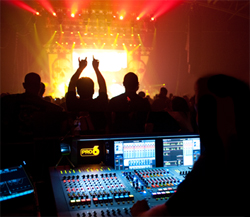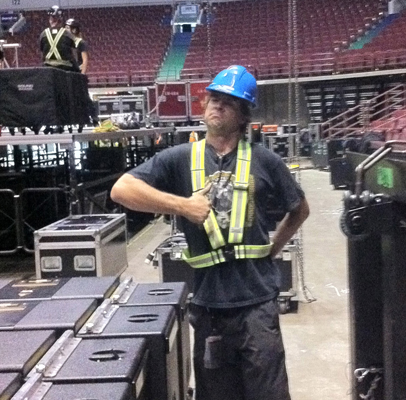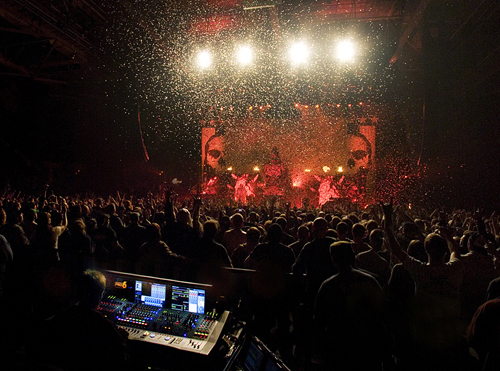
The drum kit of Ginger Fish gets the most mic attention – Shure Beta 91A and Heil PR 40 on kick, Audio- Technica ATM350 condensers on rack toms, Heil PR 28 on floor tom, and Shure Beta 56a (top) and Neumann KM 184 (bottom) on snare. More KM 184s handled hi-hat, ride, and overhead.
“You can’t go wrong with Neumann, it brings a lot of life to things having all them up there,” he says. “I love the ATM350s – they’re a great sounding tom and floor mic. The Heil PR 40 seems to translate the kick drum the way the artist wants it.”
For Slayer, Quinby notes that “kick drum is the main source for Slayer.” His approach is to outfit drummer Dave Lombardo’s kit with two Shure Beta 91As for the interior and two Heil PR 48s for the exterior of the kick drum. Heil PR 31s (top) and PR 22s (bottom) are the choice for snare, with dual Sennheiser e609s and PR 31s for toms and PR 40s for floor toms. KM 184s do hi-hat and ride duty, and Shure Beta 98s are applied to each cymbal.
Guitar rigs for Kerry King and Jeff Hanneman have the same treatment: dual Radio JDX DIs, two PR 40s and two PR 31s. Bassist Tom Araya has a Countryman DI for pre-signal and another for post. Araya’s lead vocals are captured with a Heil PR 35.
“I close-mic everything, making sure that the diaphragm of the mic is parallel to the source. The only mics that are away from the source are the external kick mics, and that’s only because I can align them with the 91s in the kick drums using Radial Phazers,” he explains. “Each of our guitar players has three heads and six live cabinets a side, so each head gets its own signal. I also align my guitar DIs and mics with the Radials, bringing them in to get a fuller mid-range sound.”
Console Viewpoints
Transferring impact was also a key driver in each engineer’s choice of consoles – a Midas PRO6 for Lonky and a Midas XL4 for Quinby – which led to an ongoing discussion of the merits of digital versus analog. While it’s an old debate, the co-headlining bill offered an interesting setting for it to take place in.
“You get to hear the exact same system, from basically the exact same starting place,” Dowling says. “And because they both funnel through Mesa, you could hear the flavor of each console when they tuned. There is no right or wrong. They both played to their strengths.”
“The PRO6 is one of my only choices,” Lonky states. “You can drive the front end like an analog desk without the audio penalties of a digital front end. Put it in the red – it doesn’t care.” Automation also plays into his choice. “The Zombie show has a lot going on. I’ve got 40 scenes on the console.”
Lonky utilized the onboard EQ to tweak the house as well as five or so other onboard plug-ins for most of his effects needs, including Midas’ pitch shifter as a means of emulating the sound of an Eventide 533 Voice Doubler. He does carry some outboard gear, including an “old favorite” TC Electronic 2290 delay as well as two Eventide H3000s applied to Zombie’s vocal because “he’s been using them since the White Zombie days and that’s his sound.”


